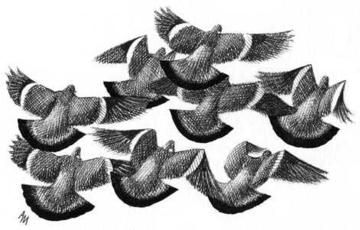
Woodpigeon © Andrew Mart
The winter survey showed Woodpigeons to be almost ubiquitous, missing only from a few of the easternmost and bleakest tetrads on the Derbyshire border and a few scattered squares elsewhere. Many Woodpigeons change habitats in winter, with more records in farmland (55% of the winter records), including 4% in stubble. Fewer (29%) were in woodland or scrub (2%), with 2% given a range of codes in the semi-natural grassland and marsh group. The changes in occupation of the ‘human site’ categories were puzzling, with half as many as in the breeding season in urban or rural areas, but much the same numbers in suburbia. They will even enter the smallest gardens if they see suitable food.
Birds were reported feeding on a wide variety of agricultural land, oilseed rape, sprouts, turnips, bare and slurried stubble, ploughed fields, horse paddocks, and improved grassland with sheep grazing. Boyd (1951) undertook a very informative analysis of the number of Woodpigeons he had recorded feeding in different agricultural crops. Their preferred order, judging from the size of the flocks, started with clover, then kale and similar brassicas, grain, newly-sown fields, pasture, and finally, least favoured, stubble, ploughed land and old potato ground. We do not know how much of each crop was available, or the extent of shooting or scaring, but the main change from today is that little clover is grown now, and oilseed rape is usually their favoured food. However, although oilseed provides Woodpigeons with a more than ample food supply, its nutritional value is low and birds have to consume vast amounts of it and spend long hours each day feeding. Higher quality food such as grain, beechmast or acorns is preferred, if available.
Woodpigeons tend to forage in groups, fieldworkers submitting 726 counts of flocks. The median size was 30 birds, with 184 over 100 and four flocks over 1,000 strong, with a maximum of 2,000 at Caldy (SJ28H) in 2004/ 05. They also gather to spend the night communally, and 96 records were submitted of flocks going to roost, with half of the counts of 100 birds or more, with seven over 1,000, topped by the gathering of 2,500 noted by Pete Hall at Toft (SJ77N) in 2004/ 05.
All previous authors have commented on winter immigration of Woodpigeons, although there is no evidence for their origins. Coward (1910) wrote that these winter influxes vary from year to year. In keeping with the norm for the time, he gave no numbers, but the winter of 1893/ 94 saw ‘an exceptional invasion’, with ‘hordes’ of the species in Cheshire, correlated with an unusual abundance of acorns. Hardy (1941) described the species as an abundant winter visitor, ‘about three times the nesting population’, with immense winter flocks roosting in woods, especially pines. Boyd (1951) recorded influxes in November and December, with winter flocks numbering many hundreds and even thousands. Bell (1962) wrote that winter immigration varies from year to year, sometime in hundreds or even thousands.
Most British adult Woodpigeons are sedentary, but first-year birds disperse up to a median distance of 30 km in midwinter, returning towards their natal area to breed. Since about 1980, the growing of oilseed rape has influenced their behaviour, with few birds moving away from areas where it is available (Migration Atlas). The large flocks that are seen moving south in some years, usually in October, might be from the highly migratory northern European populations, drifted over on their journey to Iberia to feed on the copious acorns there.
Sponsored by David and Fran Cogger in memory of Jasper

